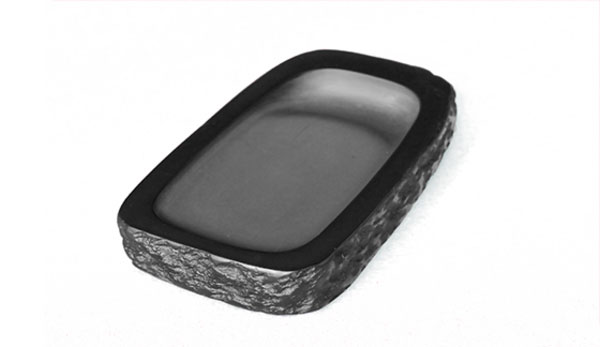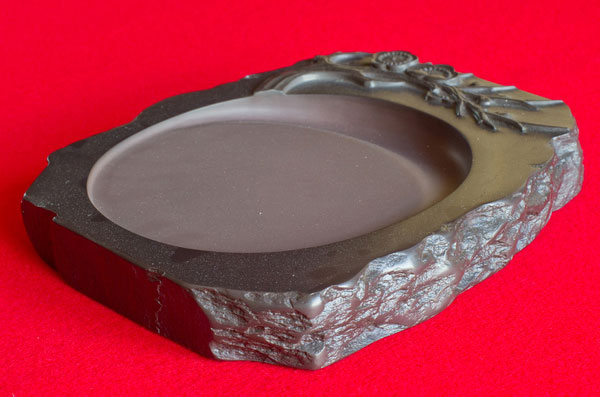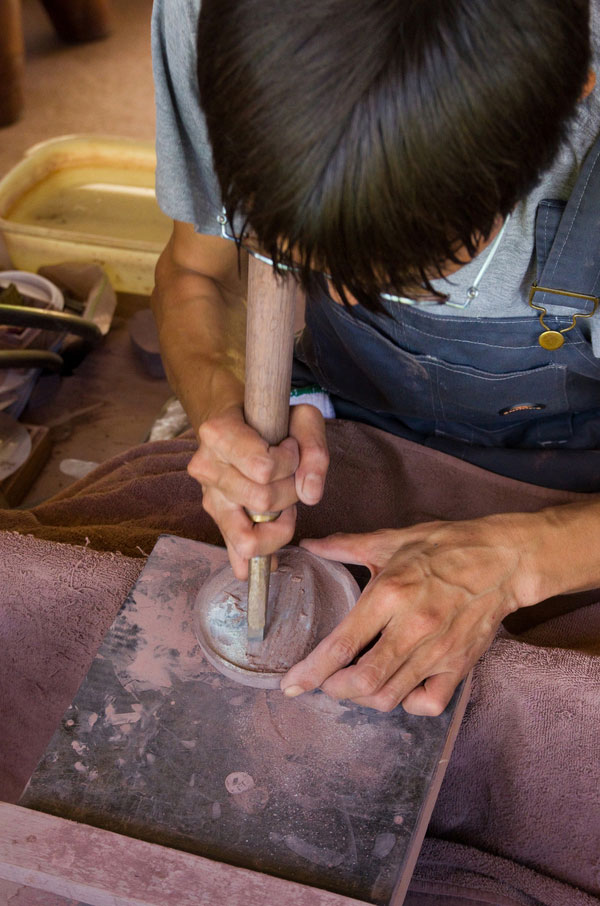 Photo:Yamaguchi Prefectural Tourism Federation
Photo:Yamaguchi Prefectural Tourism Federation
- Writing tools
- Yamaguchi
Akama inkstone Akama suzuri
High-grade inkstones from quarry to a carved masterpiece
Simple, beautiful and very practical
Description
What is Akama inkstone ?
Akama inkstone (called Akama suzuri in Japanese) is produced around the cities of Shimonoseki and Ube in Yamaguchi prefecture. A type of stone called akama, an ideal material for producing the inkstones, is used for Akama inkstone. Therefore this craft is favored for its capability of giving smooth and fine ink rubs with an excellent color and texture.
The production material, akama stone, contains a large amount of quartz and iron, which are the ideal components for inkstick rubbings. It also has a lot of stickiness, which eases the carving and allows the production of various types of inkstone. Some of these types are inkstones made of rough stone, with beautiful carved artworks, and with lids.
Artisans of this craft are known for not only producing the inkstones but also quarrying the stones themselves. Akama stone quarries require underground mining instead of surface mining as it gets dry more easily than other stones. Artisans need experience and skill for not only spotting quality stones, but for handling explosives and mining techniques. Therefore it is said to take at least ten years for an artisan to be able to mine the stone. Akama inkstones have high aesthetic value while being very practical as well.
History
 Photo:Yamaguchi Prefectural Tourism Federation
Photo:Yamaguchi Prefectural Tourism Federation
Akama inkstone has a long history of over eight hundred years as it was being manufactured in the Kamakura period (1185-1333). Akama inkstones were in fact presented by the first shogun (Japanese military dictator), Minamoto no Yoritomo (1147-1199) to Tsurugaoka Hachimangu, an ancient Shinto shrine located in Kamakura, Kanagawa prefecture where they still remain today.
From the Edo period (1603-1868), the quarrying of Akama stone was restricted by the Choshu domain (current day Yamaguchi prefecture), which increased the value of Akama inkstones as its availability was limited. For this reason, Akama inkstones were valued as gifts to domain lords. In the Meiji period (1868-1912), the amount of written records increased along with the literacy rate, which helped the production of Akama inkstones to thrive. It is said that there were around two hundred to three hundred Akama inkstone artisans from the beginning of the Meiji period to the mid-Meiji period. Ancient traditions are still preserved and handed onto the next generations although there are substantially less artisans today.
General Production Process
 Photo:Yamaguchi Prefectural Tourism Federation
Photo:Yamaguchi Prefectural Tourism Federation
- 1. Quarrying
First, akama stones that are most suitable for the inkstone are mined. There are four kinds of akama stones in addition to the generally known reddish shiunseki stone. Mined akama stone is as thick as ten meters, however only a layer of one meter can be processed for Akama inkstones.
Explosives or electric drills are used on the quarry and the mined stones will be kept in a dark, humidity controlled room for a certain period of time to preserve their quality by making sure they don't dry out. The stone is then cut to a plate shape with a hammer and a special stone cutting tool called wariya.
- 2. Bank making
The interior of the inkstone has two main parts including a deep part for the ink pool and a flat section for rubbing the inkstick or ink bank. The process of ink bank making is to roughly shape the stone into round or rectangular shapes with a circular saw and then cut the inner side with a depth of about three milimeters.
Finer adjustments of the plate shaped stone are made with a small chisel. Then the back and front surfaces of the inkstone are cut with a large chisel. The flat surface is then smoothed with either sand or water.
After the rough shaping, the area of the bank where the inkstick is rubbed and the ink pool are determined.
- 3. Rough cutting
The bank and ink pools are cut out roughly with a large chisel and the inside of the piece is shaped. This work requires power as the handle of a chisel is laid on the artisan's shoulder and pressure has to come from the upper body during carving.
- 4. Final carving
For carved and lidded inkstones, fine engravings are made directly on the surface. Akama inkstones engravings use traditional techniques, such as relief engraving (ukashi bori) to raise the patterns, fine line engraving (ke bori) to cut delicate hair-like strokes, and beating (tataki bori) to bring out the natural texture of stone. These techniques are all done by a type of chisel called tagine. Sometimes it can take weeks to carve intricate designs on the inkstones.
Moreover, there are seven to eight types of small chisels used for the internal carving. The most difficult part in the inkstone production is the boundary link between the ink bank and shore. Chisels with a width ranging from two to ten millimeters are used for carving.
- 5. Polishing
When the carving is complete, any chisel marks are polished away. Then, the surface is smoothed with a rough whetstone and sandpaper is used for a finer polish. However, over-polishing may cause difficulty when rubbing inksticks. Therefore the final polish is done with a medate stone to avoid this issue.
Japanese lacquer is applied everywhere except the ink bank and shore to prevent the inkstone from weathering.
Where to Buy & More Information
Akamatsuzuri No Sato
-
Address
-
Tel.+81-836-67-0641
-
ClosedAround the New Year
-
Business Hours9am to 5pm
-
Website
See more Writing tools
- Kumano brushes
- Ogatsu inkstone
- Akama inkstone
- Unshu abacus
- Banshu abacus
- Nara brushes
- Suzuka inksticks
- Toyohashi brushes
- Kawajiri brushes
- Nara Ink































































































































































































































































































